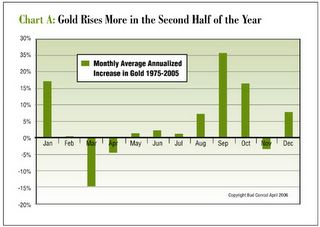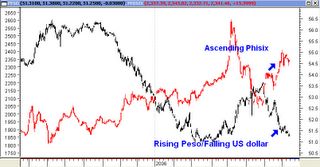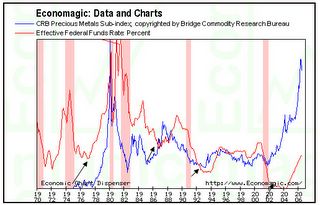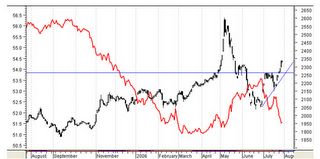The art of economics consists in looking not merely at the immediate hut at the longer effects of any act or policy; it consists in tracing the consequences of that policy not merely for one group but for all groups—Henry Hazlitt
Sunday, August 27, 2006
Time: An Investor’s Friend
Sunday, August 20, 2006
Gold Conundrum: European Banks Selling Behind the Curtains vs. Seasonal Strength?
``And when voters get scared, politicians leap into action. Unfortunately, fast government action almost always results in irrational action.”-D.R. Barton is the editor and founder of Traders’ Tuesday, and editor of the E.S.P. Profit System.
Figure 6: CaseyResearch.com: gold Rises more in the Second Half of the Year
Market maven Mr. Casey remind us of India’s share as a major consumer of the gold jewelry segment as substantial, he says ``In fact, in 2005 Indian gold jewelry sales rose by 25%, and now that country takes credit for about 23% of the world's consumer gold sales. The
Figure 7 shows that during the past three years, gold has markedly used August for its springboard towards a yearend rally.

Perplexing Ambiguities in the Global Financial Markets
``Money, again, has often been a cause of the delusion of the multitudes. Sober nations have all at once become desperate gamblers, and risked almost their existence upon the turn of a piece of paper.” Charles Mackay (1814-1889), British Poet, author of Extraordinary Popular Delusions and the Madness of Crowds
Figure 1 Asianbondsonline: Philippine Treasury 2-year (green) and 10-year (red) Yields headed lower
Figure 2: Stockcharts.com: A Resurgent Dow Jones World Stock Index (red-black) and Dow Jones Asia Pacific Index (black)
Figure 3: US Global Investors: Baltic Dry Index on a 52 week high!
Figure 4: Bond Market Association: Surging Credit Instruments (mortgage related securities,
Figure 5: Mish Shedlock’s The Survival Report: Option Expiration rallies

Friday, August 18, 2006
People's Daily Online: ASEAN officials seek to speed up building of AEC
I have noted that the increasing trend of regionalization will enhance crossborder investments, which should also translate to corresponding advancement in the financial markets. According to China's People's Daily online,
"The AEC is a unified community similar to the European Union that ASEAN hopes to establish by 2015 through various ways, such as the integration of business sectors.
Progress finally taking shape?
Sunday, August 13, 2006
A Knee Jerk Reaction to the Foiled Terror Plot in UK
``Nobody likes the idea of Peak Oil. Firstly, you have the politicians. Naturally, a politician will never say that there is such a thing as Peak Oil. It is suicide to give bad news, so a politician will never do that…Secondly you have the media. The media do not like Peak Oil. Why? There is no sponsorship for Peak Oil. The oil companies do not like Peak Oil because you should not say that your soup is cold; you should always say that it is very hot and very tasty, yes? So nobody wants to hear of this phenomenon of Peak Oil.” -ALI SAMSAM BAKHTIARI, retired “senior energy expert,” formerly employed by the National Iranian Oil Co. (NIOC) of
Figure 5: stockcharts.com: Heavy Loses in Oil and Gold on terror plot
Figure 6: NASDAQ: Technology Bust not 9/11 is the Culprit
Further, based from the initial reports of the botched plot, it would appear that the terror group’s attempt to wreak havoc in the scale of 9/11 encountered a serious breakdown in its operational security; either intelligence efforts by the respective authorities have succeeded in sufficiently penetrating the group’s operations or a would be participant turned cold feet as to snitch on the conspirator’s grand design. This means that the group’s potentials had been severely degraded, and that efforts to regroup and redeploy would take sometime and possibly utilize other areas as staging points for future operations. Therefore, one should expect the carry-on effects to be minimal, if not knee jerk or reactionary, unless of course, other publicly unseen factors working behind the present developments in the financial markets remain camouflaged. 
Inflationary Proclivities of Central Banks
``Lenin is said to have declared that the best way to destroy the Capitalistic System was to debauch the currency. . . Lenin was certainly right. There is no subtler, no surer means of overturning the existing basis of society than to debauch the currency. The process engages all the hidden forces of economic law on the side of destruction, and does it in a manner which not one man in a million can diagnose." John Maynard Keynes, The Economic Consequences of the Peace, 1920, pg 235.
Figure 1: Stockcharts.com: JP Morgan Emerging Market Index (black-red) JP Morgan Emerging Market Debt Fund (black)
Advances in bond prices (declining yields) have outperformed equities of late, as the chart above shows. These activities suggest that investors have been factoring in a slowdown in world economic growth. For the week, as the Phisix fell (-.89%), ASEAN markets were mostly on the upside, particularly
Figure2: Bloomberg: Relative Performances;
Figure3: Ascending Phisix (Red candle) on the backdrop of a falling US dollar/rising Peso (black candle)
According to the Bureau of Public Debt, TIPS or Treasury Inflation Protected Securities ``are securities whose principal is tied to the Consumer Price Index. With Inflation the principal increases. With deflation, it decreases.” In short, TIPS are sovereign debt instruments with yields computed based on activities of the Consumer Price Index as a measure of inflation.

Sunday, August 06, 2006
August 8th is Crunch Time; Market Expectations Runs Against History!
``Short the industry which the majority of
Figure 1: Economagic: 10-year Treasury (blue) Fed Funds rate (red)
Figure 2: Economagic: Tradeweighted US Dollar Index (blue) and Fed Fund Rate (red)
Figure 3 Economagic: S & P 500 (blue) and Fed Funds Rate (red)
Figure 4 Economagic: CRB Precious Index (Blue) and Fed Fund Rate (Red)

Phisix Looks Bullish, Eyes the FED
``My approach works not by making valid predictions but by allowing me to correct false ones." George Soros
Figure 5: Stockcharts.com: Weekly Phisix

Monday, July 31, 2006
FinanceAsia: Megaworld steps up with new high-yield debt deal
Sunday, July 30, 2006
Liquidity Driven Rally Amidst A US led Slowdown?
``Fear not for the future, weep not for the past." - Percy Bysshe Shelley (1792-1822), English Poet
Figure 4: Stockcharts.com MSCI Emerging Free (red line) and MSCI World Index (black line)
Figure 5: The Phisix (black candle) and the
Figure 6: BCA Research: Global Earnings Revised Down
![]() The path of least resistance for global earnings estimates is down until economic growth prospects turn-up anew.
The path of least resistance for global earnings estimates is down until economic growth prospects turn-up anew.






















